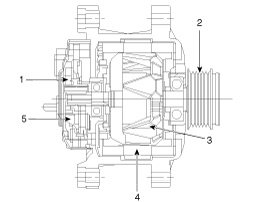 Hyundai Sonata: Description and Operation
Hyundai Sonata: Description and Operation
Description
The charging system includes a battery, an alternator with a built-in
regulator, and the charging indicator light and wire.
The Alternator has built-in diodes, each rectifying AC current to DC current.
Therefore, DC current appears at alternator "B" terminal.
In addition, the charging voltage of this alternator is regulated by the
battery voltage detection system.
The main components of the alternator are the rotor, stator, rectifier,
capacitor brushes, bearings and V-ribbed belt pulley. The brush holder contains
a built-in electronic voltage regulator.

1. Brush
2. Dirve belt pulley
3. Rotor
4. Stator
5. Rectifier
Alternator Management System
Alternator management system controls the charging voltage set point in
order to improve fuel economy, manage alternator load under various operating
conditions, keep the battery charged, and protect the battery from over-charging.
ECM controls generating voltage by duty cycle (charging control, discharging
control, normal control) based on the battery conditions and vehicle operating
conditions.
The system conducts discharging control when accelerating a vehicle. Vehicle
reduces an alternator load and consumes an electric power form a battery.
The system conducts charging control when decelerating a vehicle. Vehicle
increases an alternator load and charges a battery.
 Charging System
Charging System
...
 Repair procedures
Repair procedures
On-vehicle Inspection
•
Check that the battery cables are connected to the correct
terminals ...
See also:
Cup holder
WARNING - Hot liquids
Do not place uncovered cups of hot liquid in the cup holder while the
vehicle is in motion. If the hot liquid spills, you may burn yourself. Such
a burn to the driver c ...
Rear Cross Member. Repair procedures
Replacement
1.
Remove the rear wheel & tire.
Tightening torque:
88.3 ~ 107.9 N.m (9.0 ~ 11.0 kgf.m, 65.1 ~ 79.6 lb-ft)
...
General Information
General Information
The supplemental restraint system (SRS) is designed to supplement the
seat belt to help reduce the risk or severity of injury to the driver and passenger
by activating an ...
